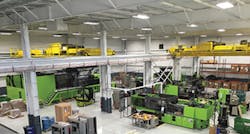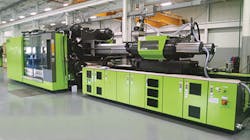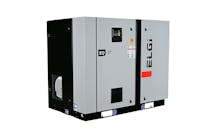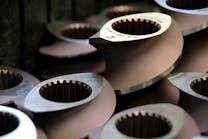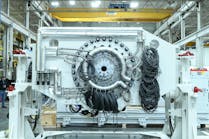Engel Austria GmbH, Schwertberg, has partnered with two technology centers in the Detroit area, in an example of how equipment and machinery companies are working together to offer turnkey injection molding systems to OEMs and tiered suppliers in the automotive market.
Christoph Steger, chief sales officer at Engel, said that the partnerships will allow Engel to introduce its latest technologies to address certain requirements for the North American automotive market, namely, the need for weight reduction and greater efficiency.
SA Engineering Technology Center
The first center held its grand opening on June 29, the same day as Engel's trend.scaut event in Livonia, Mich. The SA Engineering Technology Center in Livonia is a response to requests from OEMs and tiered automotive suppliers that are looking at global technologies and are interested in developing these technologies further for mass production consideration, according to SA Engineering. SA Engineering is a new technology company that is owned by SA Automotive of Detroit; its holding company is AESSE Investments Ltd., New Orleans.
Lidya Araya is the corporate branding manager with AESSE Investments. She said the goal is to make this a key research and development center. The facility is 42,000 square feet and has five Engel injection molding manufacturing cells that are available for process development, mold trials and technology testing.
Open house attendees toured the facility and saw the manufacturing cells up close. In addition to Engel, the other suppliers include Trexel Inc., Wilmington, Mass., INglass USA Inc., Byron Center, Mich., and Matsui America Inc., Hanover Park, Ill.
At the new facility, the injection molding systems feature state-of-the-art technology with presses that range from 285 to 3,500 tons of clamping force. Each is equipped with an integrated Engel robot and advanced processing capabilities. Three of the machines are MuCell-capable, according to Trexel, and are equipped to run with Trexel's latest T-series gas dosing systems, which are located on site. Trexel also has its North American automotive technical team located at the center.
On an Engel duo press with 660 tons of clamping force, the MuCell process was being used at the open house to make an automotive reservoir. This manufacturing cell was equipped with an Engel viper 20 robot. Levi Kishbaugh, VP of engineering with Trexel, said that the MuCell foaming technology allows design flexibility and design freedom in automotive parts.
An Engel duo wide-platen injection press with 1,650 tons of clamping force was equipped with an Engel viper 60 robot with a mold from Georg Kaufmann Formenbau AG, Remetschwil, Switzerland. It used Engel's coinmelt injection compression molding technology to perform a new application for the process — a luggage compartment cover. The main goal is maintaining mold alignment, said Michael Fischer, sales manager, technologies, for Engel Austria. That requires precise movement of the machine and control of hydraulics.
With coinmelt, there is greater uniform pressure and part quality, Fischer said, resulting in less distortion. This, of course, minimizes the chance for warp in the part, which translates to more accurate big, flat parts.
On an Engel duo wide-platen machine with 1,000 tons of clamping force, officials were molding a spoiler with Engel's flomo and HRSflow's Flexflow sequential valve-gating technologies. The mold was from HRS USA Inc., an INglass subsidiary. The mold's servo-driven valve-gate system allows for better accuracy with flexible control of pressures and flow rates. In automotive parts, use of this system means surface quality improvements, said INglass plant manager Andrea Zigante.
Matsui's IHTC Series M1 induction heating and cooling system also was on display in this manufacturing cell. This technology heats a mold to a depth of about 0.1mm. Temperatures then rise immediately at a rate of 68 degrees Fahrenheit to 104 degrees Fahrenheit per second, according to Matsui. Temperatures can be set to exceed 392 degrees Fahrenheit. The mold stays hot during the molding cycle and then the temperatures decrease at a rate of about 50 degrees Fahrenheit per second. The resulting part has no weld lines and better quality and appearance. Cycle times stay the same or improve when using the system.
Hi-Tech Mold & Engineering
Hi-Tech Mold & Engineering Inc., Rochester Hills, Mich., now has a fully operational technical center on its campus in Michigan where Engel has provided a duo 3,500-ton machine, a wide-platen duo 1,000 ton machine; and a 340-ton unit without tie bars. Each is equipped with an integrated Engel linear three-axis robot. Engel will have a fourth machine installed there by the end of the year.
The technology center is a model for Industry 4.0 initiatives. The primary strategy is to integrate molds and machines, said Steve Jarzynski of Hi-Tech Mold & Engineering, who emphasized lightweighting strategies through tooling design and manufacturing and collaboration in theproduct-development cycle.
"When someone has an idea or concept, they can bring it to us right away," he said. "We're trying to continue to break down all the phases. Weight savings goals become integrated into the project."
Angie DeRosa, managing editor
aderosa@plasticsmachinerymagazine.com
Contact:
Engel Machinery Inc., 717-764-6818, www.engelglobal.com
Hi-Tech Mold & Engineering Inc., 248-852-6600, www.hitechmold.com
INglass USA Inc., 616-228-6900, www.hrsflow.com
Matsui America Inc., 847-290-9680, www.matsuiamerica.com
SA Engineering Technology Center, 734-744-9852, www.sa-engineering.com
Trexel Inc., 781-932-0202, www.trexel.com

